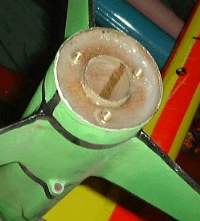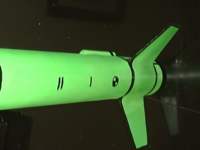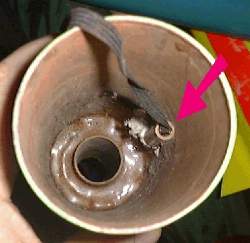| Manufacturer: | Binder Design  |

(Contributed - by Ken Johnson)
 Brief:
Brief:
Single stage rocket capable of "I" engine flights with awesome
flights on F and G.
Construction:
The Binder Design kit was complete and in good condition. The kit was purchased
at a local hobby shop because of its ability to fly on various engines. This
made it possible to fly multiple times on each launch day. F and G motors are a
good and economical motor for this kit, but it will handle H and I with no
problems. This kit diverged, somewhat, from the kits that I have been used to.
The airframe was not pre-slotted. This is something that I have gotten quite
spoiled over recently. The folks at Binder Design made cutting fin slots easy
by pre-marking the airframe with alignment markings. They were not pencil
lines, rather color coded and obvious. Even the launch lug line had been
clearly indicated with a line. The instructions were clear and concise, making
the endeavor simple. All of the parts in the kit, from the centering rings to
the plywood fins, were top quality.
I did try a new epoxy fillet method that I had read about somewhere. When I had started to fillet the outer surfaces of the fins to the airframe, I used a good sized batch of 15 minute epoxy and focused on one fin at a time. First I filled the angle with a wooden wick to approach the correct amount of epoxy for the fillet. I then drew my finger along the fillet after coating my finger with IPA. This provided for a perfectly smooth and consistent fillet. They are also about the raduis of my finger, so they look good. I also did the same to the launch lug.
 Filleting the inside joints of the fins,
motor mount tube, and the airframe was accomplished by leaving the rear
centering ring unglued. This made it easy to remove, exposing the areas that
needed to be re-enforced. This was done, rather sloppily, using wooden skewers
(for shrimp etc.) They were about 10" long and provided just enough epoxy
to get it where I wanted it. I then epoxied the aft centering ring in place and
gave it a massive alcohol induced fillet. Just as suddenly as I had finished
... I realized that I had fogotten the blind nuts that I was planning on using
for motor retention. I went to the local hardware store and purchased some
brass #10 inserts and some socket head screws. There were epoxied into minimum
diameter drill holes to ensure a snug and secure anchor.
Filleting the inside joints of the fins,
motor mount tube, and the airframe was accomplished by leaving the rear
centering ring unglued. This made it easy to remove, exposing the areas that
needed to be re-enforced. This was done, rather sloppily, using wooden skewers
(for shrimp etc.) They were about 10" long and provided just enough epoxy
to get it where I wanted it. I then epoxied the aft centering ring in place and
gave it a massive alcohol induced fillet. Just as suddenly as I had finished
... I realized that I had fogotten the blind nuts that I was planning on using
for motor retention. I went to the local hardware store and purchased some
brass #10 inserts and some socket head screws. There were epoxied into minimum
diameter drill holes to ensure a snug and secure anchor.
Minor Con's: 1) No CP/CG information in the kit; 2) very vague reference to should add nose weight; 3) had to add a HUGE amount of weight; 4) shock chord and material; 5) shock chord mount.
Finishing:
A few coats of primer, grey then white, followed by generous coats of OSHA
Safety Green, and my "Lime Away" was completed.
Construction Rating: 4 out of 5
Flight:
The recommended motors ranged from just about anything that would fit into a
29mm motor mount. The construction and components of the kit allowed for the
impulse of just about anything that I could throw at it.
I utilized my own invention for a motor retainer. This looks good and provides for positive retention. See the pics for visual. The launch day saw many unstable flights of other rocketeer's Spike kits. Binder design was not kidding when the instruction sheet states that experimentation demanded nose weighting. I had not built this into the kit becuase I wanted to have a wide range of avaliable motors.
I had marked the CP, first, and second degrees of stability in paint of the rocket. This makes for a visual for the Pad Safety Manager and helps to make them think that I know what I am doing.
 To mark the center of gravity, I used
temporary "arrows" like you use in the office for "sign
here". They are about 150 for a couple of bucks and add an air of rocket
science to the launch. I had to add 3 2.5" quick links to the nose cone
connection point to get 1.5 degrees of stability with my chosen single use
G-80-7. Another person's previous launch on a G-40 was scary, so I double
checked my stability. I loaded the body tubing with treated newspaper (blow in
insulation) and packed everything up.
To mark the center of gravity, I used
temporary "arrows" like you use in the office for "sign
here". They are about 150 for a couple of bucks and add an air of rocket
science to the launch. I had to add 3 2.5" quick links to the nose cone
connection point to get 1.5 degrees of stability with my chosen single use
G-80-7. Another person's previous launch on a G-40 was scary, so I double
checked my stability. I loaded the body tubing with treated newspaper (blow in
insulation) and packed everything up.
I added 8 oz. I calculated that I would need 12 with a 29/180 or 240. The 240 does not change it because the additional length is too close to the CG/CP.
The nose cone just did not want to fit properly. It was REALLY loose until the last 5mm of exit from the body tube. It helps to remove the mold marks from the nose cone/shroudline mount. Nothing that a quick exacto knife wouldn't take care of. It did require several layers of masking tape to secure.
My rocket was loaded on the mid power pads and lit on the first try (a copperhead even!). Straight up and out of sight. This kit will be a long standing rocket in my collection.
 Recovery:
Recovery:
The one interesting and disturbing aspect of the kit was the shock cord mount.
I do understand Binder Design's reasoning, but it was bothersome. None the
less, I decided to follow the kit's instructions and build it as supplied. The
shock cord mount was nothing more than a small diameter launch tube about an
inch and a half long that is epoxied to the inside of the airframe as far down
as you can get it, close to the upper centering ring on the motor mount.
Binder's reason for this was the ease of replacement after a burnthrough.
Sounds good to me. It took a little effort and standing on my head to get what
I thought was a proper bond and amount of epoxy on the shock cord mount, but it
was not impossible.
The shock chord is about 3/8" wide, black elastic that is about 50" long. The chute is looped and tied 2/3rds of the way from the airframe to the nose cone.
I tied one corner of a white hankerchief to an 8" long string and poured about a cup of construction chalk (red) into the center. I then carefully folded the hanky into a tight ball and placed it on top of the cute. Awesome red chalk cloud at recovery. Since I followed the instruction for the mounting of the shock cord, there was no damage. Even with all of the preparation for the chalk, it was still everywhere. But what a nice finish!
Flight Rating: 5 out of 5
Summary:
This kit is not one for the light hearted. Some kit experience is necessary to
make this kit rock solid and inexpendable. I think this kit will survive an
auger-in and still launch in half an hour. I am going to purchase another one
of these and fiberglass it.
Binder Design has brought us one more awewome kit for a good price. Good job!
Overall Rating: 4 out of 5
 |
 |
Flights
 |
 |